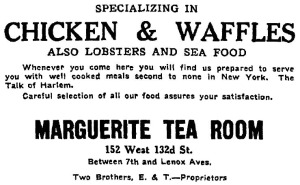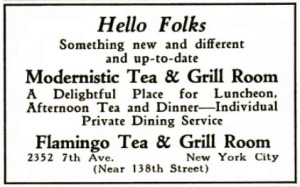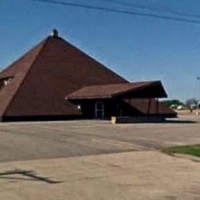When I wrote my book about the history of tea rooms, Tea at the Blue Lantern Inn, I knew very little about tea rooms run by and for African-Americans. There were few historical sources available on the internet then and even a research trip to Chicago turned up nothing. Since then I’ve discovered that there were many of these tea rooms and that they shared numerous characteristics with tea rooms run by and for whites, yet were also different in significant ways.
It’s easy to see why black women, and men, wanted to create their own tea rooms. For one thing, even in states where Jim Crow policies were not enacted into law it was common for white-run tea rooms and restaurants to engage in racial discrimination. Secondly, starting a business represented the fulfillment of the idea of self-help for blacks as advanced by leaders. Perhaps that was what inspired Mittie Burgess, a Georgia-born caterer in her late 30s, to name her newly opened 1916 place in Lexington KY the Booker T. Washington Tea Room. Although Mittie’s tea room was in the South, quite a few of the proprietors I’ve been able to trace were part of the 20th-century’s Great Migration of Southern blacks to Northern cities.
Like white tea room proprietors, blacks who took up this business tended overall to be of higher social status than the average restaurant owner, white or black. Proprietors I’ve come across included a woman who was a former pharmacist and a man who had been a college professor. Some of the more elite women who operated tea rooms were married to life insurance executives, ministers, doctors, and successful business men. Others were wives of porters, cabbies, and chauffeurs but still seemed to have achieved standing in their communities.
The advertisement for the 1922 opening of Mayme Clinkscale’s Ideal Tea Room [shown above] in Chicago said it was designed for club, society, and lodge banquets, and furnished with “the latest and best in silverware, linen, and glassware.”
 A number of tea rooms were clearly meant for the black upper crust. Common phrases in advertisements and news stories include “exclusive,” “the elite of the city are found [here],” or “where the wealthier class of colored people dine.” Mentions of table appointments and decor often include silver bud vases, exotic themes, and carefully coordinated color schemes. Menus offered fried chicken and corn sticks as well as steaks and salads, but were less likely to list rural Southern favorites such as pigs’ feet or greens.
A number of tea rooms were clearly meant for the black upper crust. Common phrases in advertisements and news stories include “exclusive,” “the elite of the city are found [here],” or “where the wealthier class of colored people dine.” Mentions of table appointments and decor often include silver bud vases, exotic themes, and carefully coordinated color schemes. Menus offered fried chicken and corn sticks as well as steaks and salads, but were less likely to list rural Southern favorites such as pigs’ feet or greens.
Tea rooms in African-American communities in the teens, 20s, and 30s, frequently hosted important social events. Community leaders hailed them as badly needed establishments. Groups such as the NAACP Women’s Auxiliary, black sports writers, and the Negro Business League held luncheons and dinners at tea rooms. Red Caps from Grand Central and Penn Station hosted their peers at the Gilt Edge Tea Room during a national convention in NYC. Newspaper people from the black newspaper The Amsterdam News celebrated a colleague’s college graduation at Harlem’s Jack and Jill Tea Room in 1928. They certainly received a warmer welcome than had Charlotte Bass, black publisher of the California Eagle, when she and several of her guests were refused service at the white-run Old Adobe in Ventura CA.
 Since they were small and did not make money from alcoholic beverages (not legally anyway, during Prohibition) all tea rooms were hard to operate profitably. Yet I sense that owners of Afro-American tea rooms had to work even harder than whites to succeed. They seem to have been open much longer hours, covering meals that ran from breakfast until late into the night. They were also more likely than white tea rooms to offer entertainment such as music and dancing. Many took in table boarders, regular patrons who contracted to eat their meals there for a week or month at a time.
Since they were small and did not make money from alcoholic beverages (not legally anyway, during Prohibition) all tea rooms were hard to operate profitably. Yet I sense that owners of Afro-American tea rooms had to work even harder than whites to succeed. They seem to have been open much longer hours, covering meals that ran from breakfast until late into the night. They were also more likely than white tea rooms to offer entertainment such as music and dancing. Many took in table boarders, regular patrons who contracted to eat their meals there for a week or month at a time.
© Jan Whitaker, 2011













 It's great to hear from readers and I take time to answer queries. I can't always find what you are looking for, but I do appreciate getting thank yous no matter what the outcome.
It's great to hear from readers and I take time to answer queries. I can't always find what you are looking for, but I do appreciate getting thank yous no matter what the outcome.



Thank you so much for sharing this nugget. I’m currently searching historic black tea rooms and it’s key owners and chefs.
Pingback: Introducing Ella Williams - Stories of Sisters
I am an owner of the Ase Tea Room in Philadelphia. I’ve enjoyed the information, but more importantly the inspiration. We often limit ourselves due to lack of knowledge of those that came before us. This article was a tribute to our ancestors that have been forgotten in the world of tea. Dr. Alston
Thanks, glad to hear that.
Pingback: Tiktok's Karens Mad at "Black Girl Follow Train" - Taylorbeemedia
Pingback: Tiktok's Karens Mad at "Black Girl Follow Train" - Venture Daily News
Good day all. Is there a book about these tea houses? I am so happy that a friend brought this story to my attention. I have a tea business in Ohio.
Unfortunately not. I have found that it’s not an easy subject to find a lot of historical material about.
I cannot thank you enough for this information; a dear friend of mine in England posted it on her page. I have collected and enjoyed teaware for 4 decades; you always hear about the restaurants we owned yet never the “Tea Rooms” during segregated times. The taking of tea was generally at home or at church that I am aware of. My first tea set came for my Aunt Bee when I was about 7/8 years old; we still enjoy tea time almost 60 year later. I learned how to set the table from my grandmother (she was a widowed maid with 6 children until she was able to go to school for nursing). The stories, etiquette and recipes are priceless…their sacrifices allow us to be owners again, tea connoisseurs/sommeliers, writers/bloggers. More than likely my collection of teaware was not owed by us except for a few precious family heirlooms.. Now it is and I can tell new stories with quality pieces we may never see again or maybe it is time to create our own.
Thanks very much for your comment.
Pingback: Sunday Scraps #63 – designswarm {thoughts}
Pingback: Historic African American Tea Rooms – American Royal Tea
Thank you for sharing this history. As an African American tea owner here in Atlanta, Georgia, it gives me great joy that I am able to live out what my ancestors paved for me.
I’m happy to know that!
Hello Mariyah,
What is the name and link of your shop? I am writing a novel about Great Migration women who settle in Oakland and a tearoom is featured where they gather in Oakland, California. There was a Black owned tea shop in the 1980s and 90s in Oakland in the same location in my book.
@Mariyah Where is your location? I live here and am in a black tea group on FB and would like to connect and visit your location.
Thank you for an interesting read. I am African-American (originally from England) and love to visit tea rooms when back in the UK. I never knew that America had a history of tea rooms (for whites or blacks). Wonderful.
I am very intrigued with your blog on American American tea rooms. Would you be interested in doing a video conference with my group on your research and the history?
Sure. I’ll send you an email.
This is an amazing wealth of knowledge. I own a small tearoom in Brooklyn. Did you come across any artifacts in your research. I add something from this history to our decor.
Looks like you have an attractive place. You are carrying on a good tradition, though the tea rooms of old (both African-American and white) were mainly lunch places and not so big on tea as a beverage. I didn’t find any artifacts since my main source is historic newspapers.
Greetings Ali:
Where is your tea room in Brooklyn? I would love to stop by.
I was wondering where I can find more information on the AA tea room experience. I want to recreate this event for Black History month next February. I did not know they served food I thought it was tea and light finger sandwiches. I have so much to find out any help would be greatly appreciated.
Hi Michele — I will look at my notes again, but I don’t think I have any menus from AA tea rooms. I think you’d be fine with tea and little sandwiches though — calling it afternoon tea, not lunch. — Jan
Checked my notes and they don’t say much about food, but here are a few things. Keep in mind that some of the tea rooms were also boarding houses that provided meals to regular guests.
— The Blue Bird Café and Tea Room, Baltimore, 1928, has a special Sunday menu of Roast Beef, Chicken or Fish, with mashed potatoes, peas, Waldorf salad, apple pie
— The Dearing Tea Room, Pittsburgh, 1935, serves Sunday dinners of vegetable soup, fried chicken, Porterhouse steak, shoestring potatoes, smothered chicken with mushroom sauce, combination salads, mashed potatoes, kale, green apple cobbler
— Ann Harper’s Tea Shoppe, NYC, 1938, says corn sticks are the specialty
I have also asked a friend who is AA and gives talks about tea to see if she has any better information.
Thanks. I am looking for any ‘real’ information/pictures of AA Tea Ceremonies. Judy
I’ve never run across any, but I would think if you could look at old college yearbooks from Black colleges you might find something about a sorority event or something like that.
Try Black Southern Belle
https://blacksouthernbelle.com/
Thank you for sharing this history. As a AA tea owner in the south, it’s an honor and a privilege to have had pioneers to pave the way for our bustling business. Cheers!
Thanks! What is the name of your tea shop and where is it?
I work for a developer. We are building the 2nd phase of a development in a historically African American neighborhood and we want very much to ensure opportunities to African Americans in the area. Our outreach has revealed that a coffee shop/tea shop is desired within the market area, but we haven’t found any African Americans interested in starting this type of business. We are in Oklahoma City. Does anyone know where I might begin looking to recruit (outside of the area if necessary) for this type of business opportunity. The challenge is that the business must be able to afford the rent which means lots of coffee/tea to be sold. But our development is next to a major university center, and will be putting approx 500 new residents in the area, so the business would have a captive audience.
That sounds wonderful. It has always been my dream to open a Bed & Breakfast that features afternoon tea.
Happy, very happy to learn of African American Tea Rooms. I tea all the time and give teas and share our history. Thank You!
Thank you for publishing this article. I teach tea etiquette and I was looking for information on African American tea rooms. My grandmom and aunties use to give afternoon teas when I was a little girl. I am trying to find pictures for my presentations.
Interested
In rural areas, didn’t grandmothers sponsor tea time with their fellow sisters in christ in their homes? I don’t think they had tea rooms in virginia or west virginia.
I’m sure you are right that women in rural areas gave teas in their homes. I know there were white tea rooms in those states but I’d guess they were not welcoming to Afro-American patrons, plus they were not usually in rural areas. So far, at least, I haven’t discovered any A-A tea rooms in VA or WV.
Yes, Afternoon was most often served at home or at Church (My mother is from Alabama and my dad is from Georgia). I remember visiting a gorgeous old church in Harlem, NY that has a sitting room where the ladies would have tea/coffee and sweet meats in between church services or during meetings. I would love to see this come back.
Inspired by your post and would like to include a link to this article in my post.
Thanks, go right ahead.
This is the first, and probably last, time that I will add a comment to a blog; however, there is an up and coming African American tea room in Harlem, NY called CuriosiTeas and the owner is a beautiful, kind soul.
Jan, I Love the information. I am studying tea, working on certification through the Specialty Tea Institute in New York and planning on opening a tearoom in Michigan. Trying to find information on the black experience and tea is difficult. May I please quote your blog in my “tea talks?”
Thank you, Tresa
Tresa, I’d love it if you did. Thanks.
This was very nice to read as I am a black woman and own a tea room in Decatur, Georgia. I hope you don’t mind that I did share this posting as well via my facebook. Again thank you for sharing the history.
Fabulous!
Wonderful information… I had no idea African American tea rooms ever existed! Very inspiring, my friends are going to “recreate” one in honor of Black history month! I tried to find more information but couldn’t find any. Thanks!!
Tanya
Happy holidays!
Love this article…question-did you find any african american tea rooms in the District of Columbia?
Thanks! Not yet but if I do I will add something. There must have been some.
I wonder if Harlem’s Jack and Jill Tea Room, noted above, is connected in any way with the organization “Jack and Jill,” a wellknown organization for middle-class black families and their children. It is at least interesting that a tea room and an organization, both connected to black elites, would share this rather ideosyncratic name. Anyone know anything about this?
I would not be surprised if it is connected to Jack and Jill. Members of my family are Delta Sigma Theta and raise money for Jack and Jill. I join supporting the kids and attending the events when I can.
Jan,
I love your blog! I have the link on my own blog – “My Nineteenth Life” – about 19thc American life.
Once I’m done with my current 19thc criminals series, I wanted to do entertainment, restaurants and shopping. Would you mind if I use one of your posts on my blog? You would get all the credit, of course! Let me know if that’s okay, and I’ll give you a heads-up when I would be doing it.
Thanks,
Kathy
Kathy — Sounds good to me. I like your crime theme.
Wonderful article. Glad to have the information. Of course, delightfully written too!
Thank you, Dawn.
Pingback: African-American tea rooms | Restaurant-ing through history | The African American Black Blog Directory